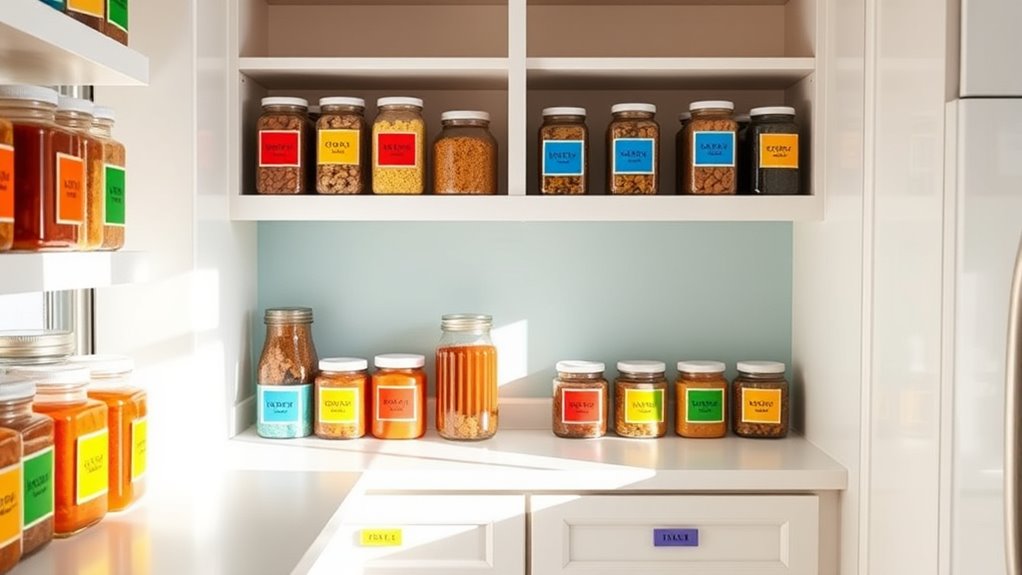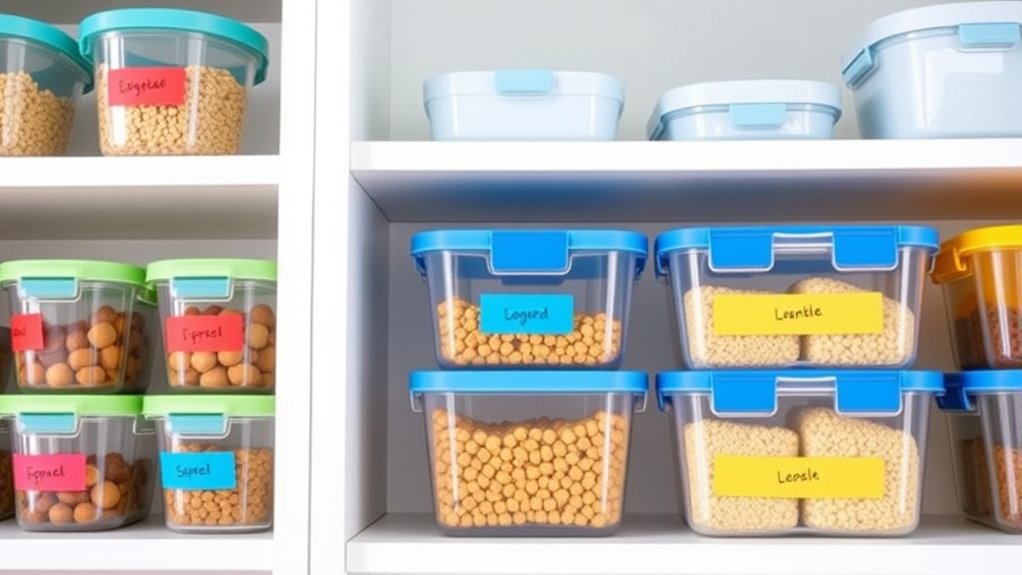Labeling and color-coding make it easier for you to find things quickly by creating clear visual cues and organized categories. By assigning specific colors and labels to items, you can instantly identify what belongs where, reducing search time and frustration. Consistent use of these signals builds habits and boosts confidence in your daily routines. If you want simple tips to enhance your organization, keep exploring to discover more effective strategies.
Key Takeaways
- Color-coding and labels create quick visual cues, helping seniors identify items instantly and reduce searching time.
- Assigning specific colors to categories simplifies organization, making it easier for seniors to find and return items correctly.
- Clear, large labels combined with contrasting colors improve visibility, especially for those with declining eyesight.
- Consistent labeling and color schemes establish habits, boosting independence and reducing daily confusion.
- Positioning frequently used items at eye level with matching labels enhances accessibility and quick retrieval.

Labeling and color-coding are essential tools for organizing and simplifying complex information, making it easier to identify and prioritize items at a glance. When you’re helping seniors manage their belongings, especially in cluttered or hard-to-navigate spaces, these methods become invaluable. They serve as quick, straightforward visual cues that reduce the time and effort needed to find what you’re looking for. Effective use of storage solutions combined with clear labels and distinct colors ensures that everything has its place, and that place is easy to recognize.
Imagine you’ve arranged a kitchen or a bathroom cabinet. Instead of trying to remember where each item is stored, you assign specific colors and labels to categories of objects. For example, all cleaning supplies could be in a bin marked with a bright yellow label, and the label itself could be color-coded yellow. This visual cue instantly communicates the purpose of that storage area, so your loved one knows exactly where to look and where to put things back. You can extend this concept to drawers, shelves, and containers, making the entire space intuitive to navigate. This not only streamlines daily routines but also reduces frustration and confusion.
Use color-coded labels to make storage intuitive and reduce daily confusion.
Incorporating color in your storage solutions isn’t just about aesthetics; it’s about functionality. Use contrasting colors or bold hues to differentiate between categories. For instance, use red for emergency medications, green for vitamins, and blue for daily supplements. Label each container clearly with large, legible text that complements the color. This combination of visual cues helps seniors build a mental map of their environment, which is especially beneficial for those with declining memory or eyesight. When everything is consistently color-coded and labeled, they develop habits that foster independence and confidence in managing their belongings. Additionally, consistency in your labeling approach enhances memory and helps establish routines. Moreover, choosing appropriate colors that are culturally meaningful can improve understanding and reduce confusion among diverse groups.
Furthermore, aligning your labels with Cultural Intelligence strategies can enhance understanding and consistency across diverse environments. Additionally, consider the practicality of your storage solutions. Use sturdy, clearly labeled containers that are easy to open and close. Position frequently used items at eye level or in accessible spots. For less-used items, designate specific storage areas with matching colors and labels. This system minimizes the need to sift through piles or open multiple cabinets, saving time and energy. Moreover, attention to detail in placement and labeling can significantly boost a senior’s ability to recall and locate items quickly. Over time, these visual cues and well-organized storage solutions become second nature, making everyday tasks less stressful and more manageable. Implementing cookie-based labeling techniques can further support consistent organization and memory recall.
Frequently Asked Questions
How Can Labeling Reduce Senior Falls at Home?
You can reduce senior falls at home by making things easier to identify. Using visual contrast on steps, handrails, and floors helps seniors see hazards clearly. Tactile markers on stair edges and doorway thresholds give physical cues, aiding balance and navigation. These strategies actively engage their senses, helping them avoid accidents and maintain independence. Proper labeling and color-coding enhance safety, ensuring seniors can find and recognize important areas quickly.
What Colors Are Most Effective for Seniors With Vision Impairments?
You should choose high-contrast colors for seniors with vision impairments, as these enhance contrast sensitivity and make objects easier to identify. Bright, bold colors like yellow or white against darker backgrounds work well. Color psychology suggests that warm, vibrant hues attract attention and improve visibility. By selecting effective colors, you help seniors navigate their environment safely and confidently, reducing risks and promoting independence.
Are There Recommended Materials for Durable Labels?
Perfectly persistent, your label needs to last! For durable labels, you should consider adhesive label options that stick securely and resist wear. Waterproof label materials are ideal because they withstand moisture, spills, and regular handling. Look for labels made from laminated vinyl or polyester, as they’re tough, tear-resistant, and designed to endure daily use. These materials guarantee your labels stay legible and in place, making life easier for seniors.
How Often Should Labels and Color Codes Be Updated?
You should update your labels and color codes whenever you notice they’re no longer clear or effective. Regular revitalizing strategies help maintain visibility, especially as needs change. Consider reviewing your color scheme updates every six months or annually to ensure they still serve their purpose. Staying proactive with these updates ensures seniors can easily find what they need, reducing frustration and promoting independence.
Can Labeling Help With Memory Loss or Cognitive Decline?
Imagine losing your keys or forgetting a loved one’s name—that’s where labeling can provide essential cognitive support. While it’s not a cure, labeling acts as a mnemonic aid, helping seniors with memory loss navigate daily tasks more independently. By creating visual cues, labels support memory retention and reduce confusion, fostering confidence. In this way, simple labels become powerful tools for enhancing cognitive function and maintaining quality of life.
Conclusion
Think of labeling and color-coding as your map and compass in a busy forest. They guide you effortlessly through familiar trails, helping you find what you need without hesitation. Just as a clear trail makes for a peaceful hike, organized labels and colors make daily life smoother for seniors. With these simple tools, you create a safe, inviting path where everything is easy to spot—turning a cluttered wilderness into a well-marked, accessible journey.









